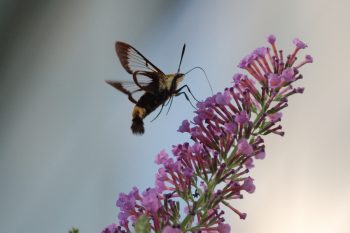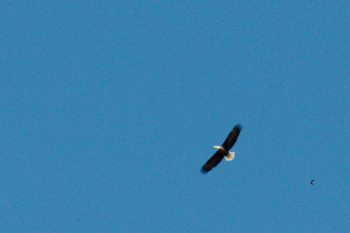Taking pictures of bees and butterflies on flowers is hard, but at least they land, if only momentarily. This is a sphinx moth and I’ve only very rarely seen one actually land. Certainly when feeding on flowers they tend to hover. Unfortunately this one was not in the sun, so it’s not shown as nicely as it might be, but beggars cannot be choosers. I’m guessing that this is Hemaris diffinis, the snowberry clearwing, but I really don’t know.
Tagged With: Moth
Sphinx Moth
Tomato Hornworm
After not being able to go out to the farm for three straight Saturdays it was nice to be able to again this morning. It was quiet and I enjoyed a little photography time in the vegetable garden. I came upon this caterpillar, which I believe is a tomato hornworm (Manduca quinquemaculata) that is covered with eggs from some parasitic insect, possibly a Braconid wasp of some sort. A little less spectacular than Alien and no Sigourney Weaver but that’s the general idea.
Polyphemus Moth Caterpillar
This thing is huge. It’s as big around as my thumb and as long as my middle finger. Actually, I think it’s pretty amazing that this big, squishy, green blob turns into a beautiful (and quite large) moth. In this case, a Polyphemus moth (Antheraea polyphemus). It’s named after the Cyclops Polyphemus in Homer’s Odyssey because of the large “eye spot” on its hindwings.
Pale Beauty
I saw a few of these little moths today. I believe it is a pale beauty (Campaea perlata).
Atteva aurea (Ailanthus Webworm Moth)
I took some butterfly pictures this afternoon, as well as some flower pictures. While sitting in the chair that Cathy was in when I took the picture for a few days ago I could get pretty close to a few flowers without having to strain my back. Then walking around I saw this prettily colored ailanthus webworm moth (Atteva aurea) on a black-eyed Susan. It took me a while to get down on the ground to get the pictures but I think it was worth the effort. Although it’s named for and feeds on a non-native tree, the Ailanthus webworm moth is actually a North American native from Florida, where its original host was the Simarouba glauca (paradise tree) and Simarouba amara.
White-marked Tussock Moth (Orgyia leucostigma)
I was sitting outside this morning, taking a break from doing some yard work, when I noticed this caterpillar on the tire of my car. I moved it to a plant, figuring it would be shown to better effect there than on the black tire, and then I got my camera and took a few photos. It is a white-marked tussock moth (Orgyia leucostigma), a species native to our region. Interestingly, the adult females are wingless and therefore flightless. If you find one of these, you’ll want to avoid handling it with your bare hands. Its hair is known to cause allergic reactions, especially in areas of the body with sensitive skin. I let it crawl onto a leaf to move it, so as to avoid any issues.
American Dagger Moth Caterpillar (Acronicta americana)
Cathy called me up from the basement this morning because she thought I might like to see this caterpillar on our back patio. It was crawling along the hose but then moved off onto some leaves and sticks, which looks a bit more natural. It is an American Dagger Moth Caterpillar (Acronicta americana). They feed on the leaves of various deciduous trees so I really shouldn’t have let it live, but I did. Apparently the hairs can cause skin irritation, so it’s something you probably don’t want to handle. I didn’t, so I cannot say whether or not it’s a serious problem.
Xanthotype Species
We went to Northern Virginia this evening to have dinner with our good friend, Jean. While we were there, eating in her car port, there was a huge downpour followed by a rainbow. It was actually really nice to be sitting outside but under cover during that. Then, I happened to spot this moth, which landed on the gate to the back yard. It’s a moth in the genus Xanthotype. There are five species in our area but, according to BugGuide, “adults of all species in this genus are, for practical purposes, externally indistinguishable from one another” so we’ll just leave it at that.
Moth and Eagle
We had some out of town guest this weekend but they were here mostly to do the D.C. tourist thing. Late this morning the headed downtown to hit the museums and Cathy and I decided to go to the C&O Canal, walking northwest from Pennyfield Lock. It was a beautiful day, warmer than I prefer but only by a little. In the shade and particularly when there was a breeze it was lovely. We saw lots of painted turtles (Chrysemys picta), a great blue heron (Ardea herodias) and quite a few wildflowers. For today’s post I’m putting up two photos. The first is an ailanthus webworm moth (Atteva aurea) on a sunflower (Helianthus) of some sort. The larvae live in communal webs on their host trees. Interestingly, while they are thought to be native to South Florida, the ailanthus for which they are named (Ailanthus altissima, Tree of Heaven), is native to Northern China. It is believed that their original larval host was the paradise tree (Simarouba glauca) and Simarouba amara. It started moving north around the 1850s when introduced Ailanthus altissima contacted the moth’s native range.
The second photo is, as you have probably surmised, a Bald Eagle (Haliaeetus leucocephalus). Cathy had walked a little further along and I waited in the shade at a pretty spot to take a few photos of the wildflowers there. While I was waiting for her to return I looked up and saw the eagle. I was able to point him out to a few others walking or biking on the canal but it was gone before Cathy returned. This isn’t the sharpest photo but it’s pretty clear what it is. The dark spot in the lower right is another bird. There were quite a few, flying fairly high in the sky.
Sphinx Moth (Hemaris sp.)
We happened to see this sphinx moth (Hemaris sp.) in our front garden this evening. The light was low so I wasn’t able to get as much depth of field as I’d have liked. I prefer not to use the built-in flash on my camera but sometimes it’s the only way to get a decent photo and I think this one turned out well enough. They are especially hard to photograph while flying and in low light but it was nice enough to land for me. These are fairly common visitors to our garden. Not like swallowtails and skippers, but something we see often enough. They are most commonly drawn to the buddleia bushes. This one, however, had been on the Verbena bonariensis.











